
Geospatial technology provider Trimble (NASDAQ: TRMB) announced better-than-expected revenue in Q1 CY2025, but sales fell by 11.8% year on year to $840.6 million. The company expects next quarter’s revenue to be around $830 million, close to analysts’ estimates. Its non-GAAP profit of $0.61 per share was 4.4% above analysts’ consensus estimates.
Is now the time to buy Trimble? Find out by accessing our full research report, it’s free.
Trimble (TRMB) Q1 CY2025 Highlights:
- Revenue: $840.6 million vs analyst estimates of $809.8 million (11.8% year-on-year decline, 3.8% beat)
- Adjusted EPS: $0.61 vs analyst estimates of $0.58 (4.4% beat)
- Adjusted EBITDA: $212.1 million vs analyst estimates of $200.9 million (25.2% margin, 5.6% beat)
- The company reconfirmed its revenue guidance for the full year of $3.42 billion at the midpoint
- Management reiterated its full-year Adjusted EPS guidance of $2.87 at the midpoint
- Operating Margin: 11.6%, in line with the same quarter last year
- Free Cash Flow Margin: 17.7%, down from 23.8% in the same quarter last year
- Organic Revenue rose 2% year on year (0% in the same quarter last year)
- Market Capitalization: $15.11 billion
"We began the year with strong momentum, delivering a first quarter record annualized recurring revenue of $2.18 billion and surpassing expectations on both top and bottom lines," said Rob Painter, president and CEO of Trimble.
Company Overview
Playing a role in the construction of the Paris Grand, Trimble (NASDAQ: TRMB) offers geospatial devices and technology to the agriculture, construction, transportation, and logistics industries.
Sales Growth
Examining a company’s long-term performance can provide clues about its quality. Any business can experience short-term success, but top-performing ones enjoy sustained growth for years. Regrettably, Trimble’s sales grew at a sluggish 1.9% compounded annual growth rate over the last five years. This was below our standards and is a tough starting point for our analysis.
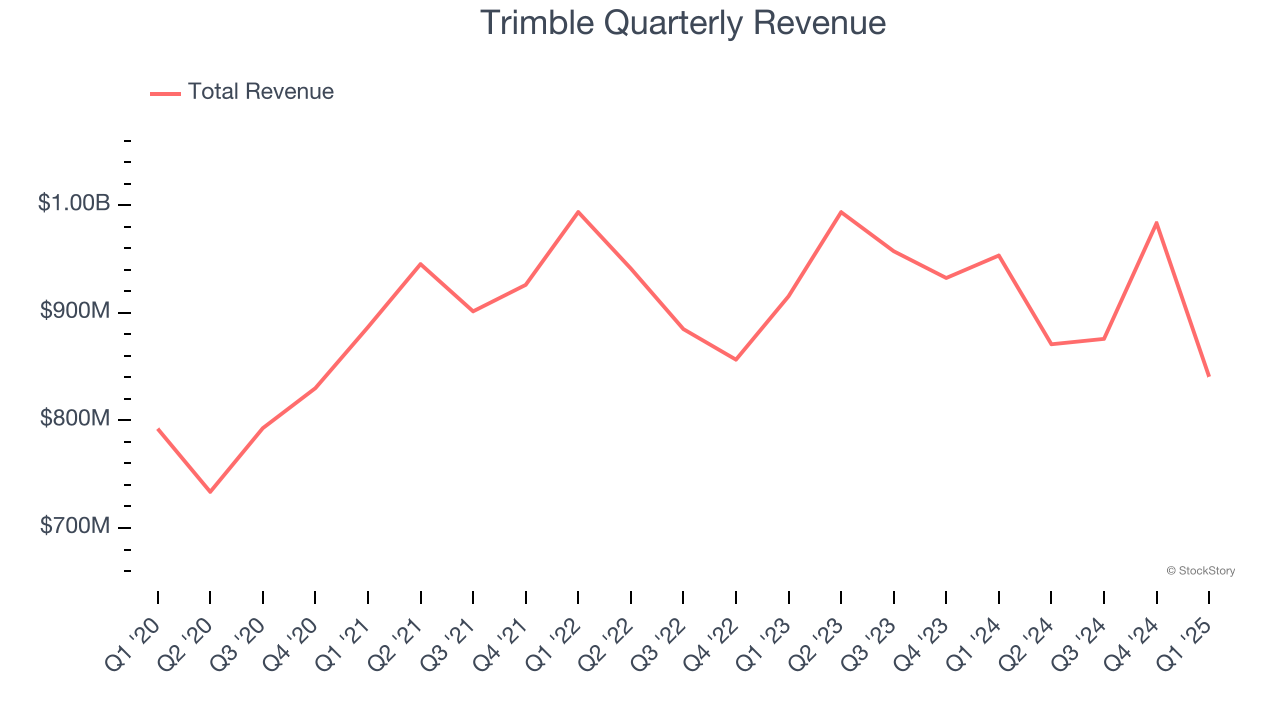
We at StockStory place the most emphasis on long-term growth, but within industrials, a half-decade historical view may miss cycles, industry trends, or a company capitalizing on catalysts such as a new contract win or a successful product line. Trimble’s recent performance shows its demand has slowed as its revenue was flat over the last two years. We also note many other Internet of Things businesses have faced declining sales because of cyclical headwinds. While Trimble’s growth wasn’t the best, it did do better than its peers. 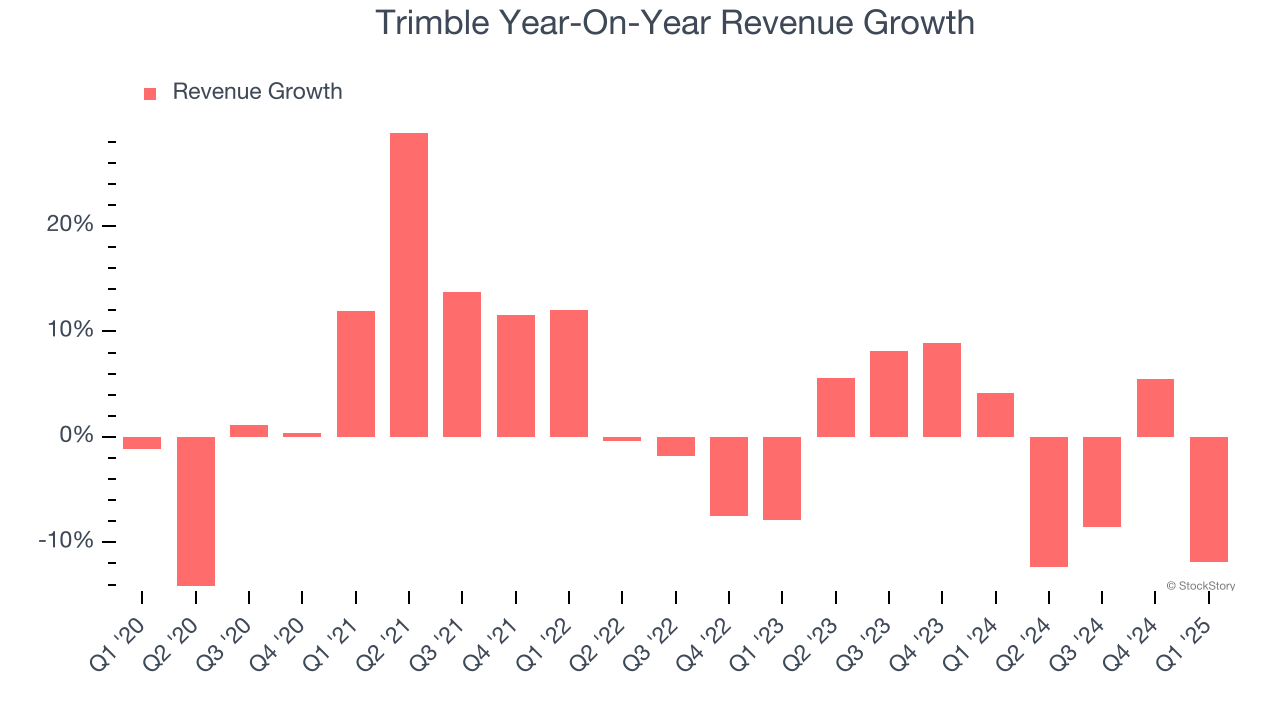
We can better understand the company’s sales dynamics by analyzing its organic revenue, which strips out one-time events like acquisitions and currency fluctuations that don’t accurately reflect its fundamentals. Over the last two years, Trimble’s organic revenue averaged 3.7% year-on-year growth. Because this number is better than its normal revenue growth, we can see that some mixture of divestitures and foreign exchange rates dampened its headline results. 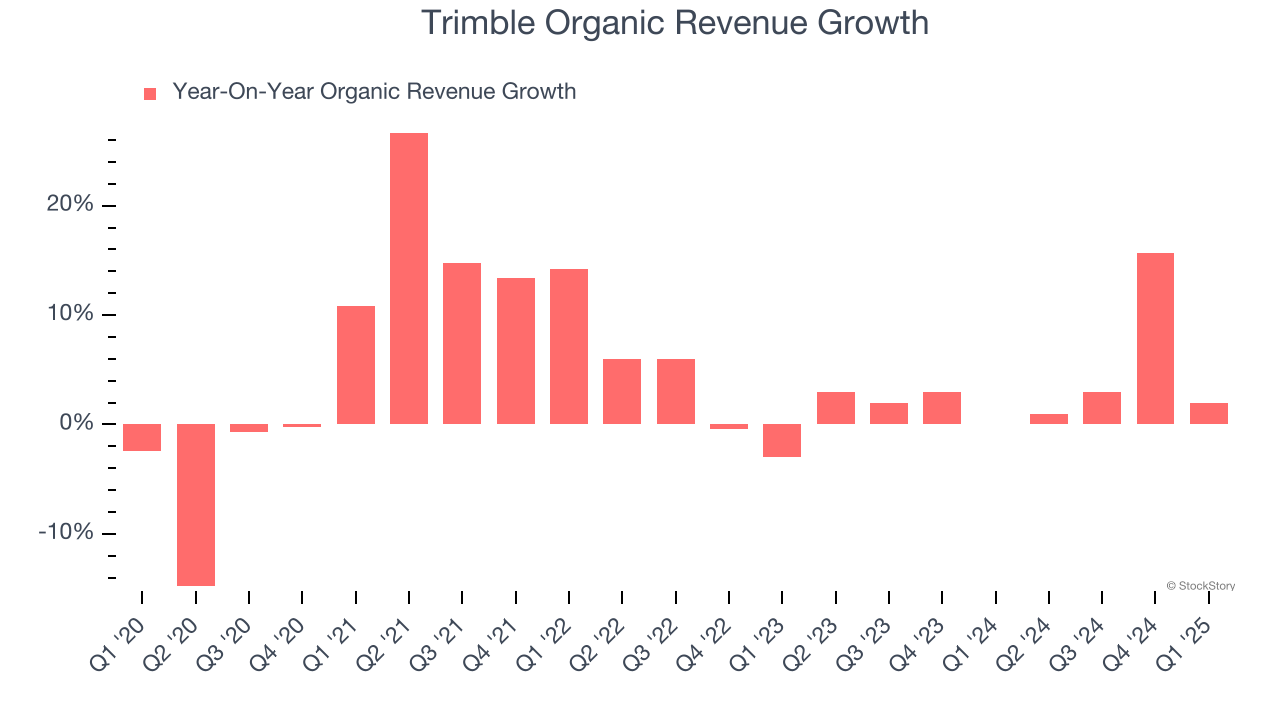
This quarter, Trimble’s revenue fell by 11.8% year on year to $840.6 million but beat Wall Street’s estimates by 3.8%. Company management is currently guiding for a 4.7% year-on-year decline in sales next quarter.
Looking further ahead, sell-side analysts expect revenue to decline by 2.8% over the next 12 months, a slight deceleration versus the last two years. This projection doesn't excite us and implies its products and services will see some demand headwinds.
Unless you’ve been living under a rock, it should be obvious by now that generative AI is going to have a huge impact on how large corporations do business. While Nvidia and AMD are trading close to all-time highs, we prefer a lesser-known (but still profitable) stock benefiting from the rise of AI. Click here to access our free report one of our favorites growth stories.
Operating Margin
Operating margin is a key measure of profitability. Think of it as net income - the bottom line - excluding the impact of taxes and interest on debt, which are less connected to business fundamentals.
Trimble has been an efficient company over the last five years. It was one of the more profitable businesses in the industrials sector, boasting an average operating margin of 13.3%. This result isn’t surprising as its high gross margin gives it a favorable starting point.
Analyzing the trend in its profitability, Trimble’s operating margin decreased by 1.7 percentage points over the last five years. This raises questions about the company’s expense base because its revenue growth should have given it leverage on its fixed costs, resulting in better economies of scale and profitability.
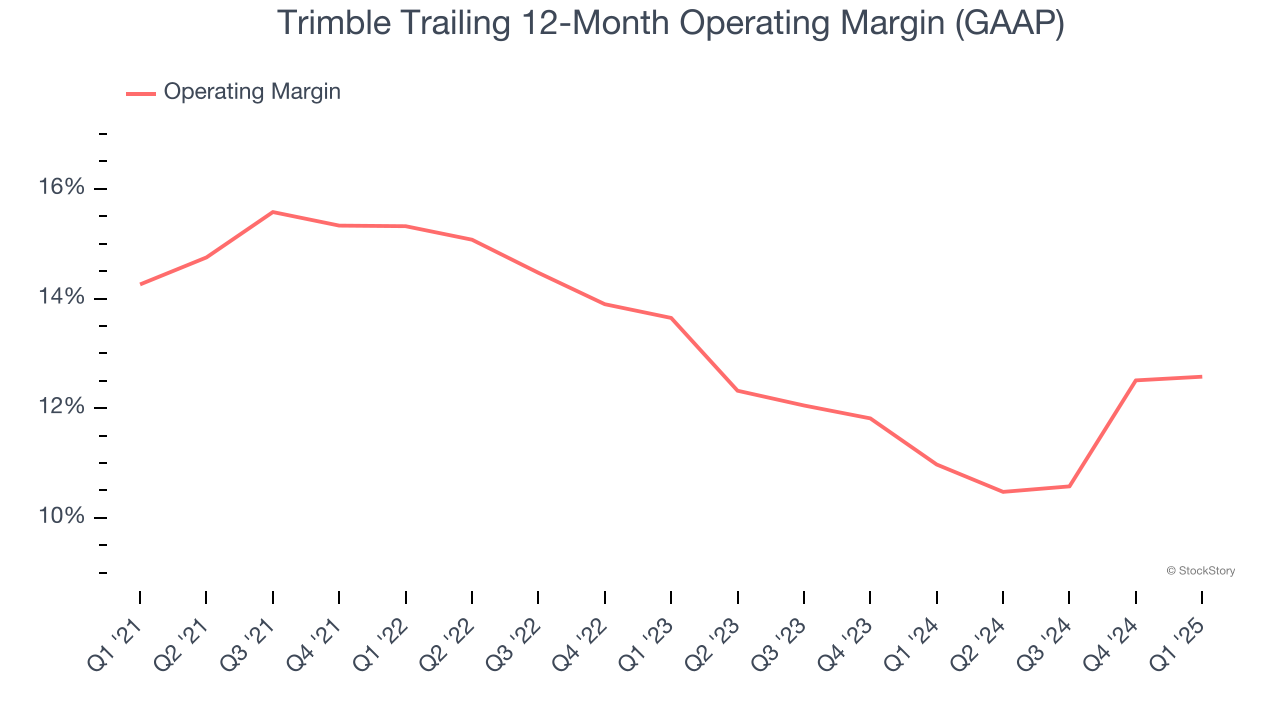
This quarter, Trimble generated an operating profit margin of 11.6%, in line with the same quarter last year. This indicates the company’s cost structure has recently been stable.
Earnings Per Share
Revenue trends explain a company’s historical growth, but the long-term change in earnings per share (EPS) points to the profitability of that growth – for example, a company could inflate its sales through excessive spending on advertising and promotions.
Trimble’s EPS grew at an unimpressive 6.8% compounded annual growth rate over the last five years. This performance was better than its flat revenue but doesn’t tell us much about its business quality because its operating margin didn’t expand.
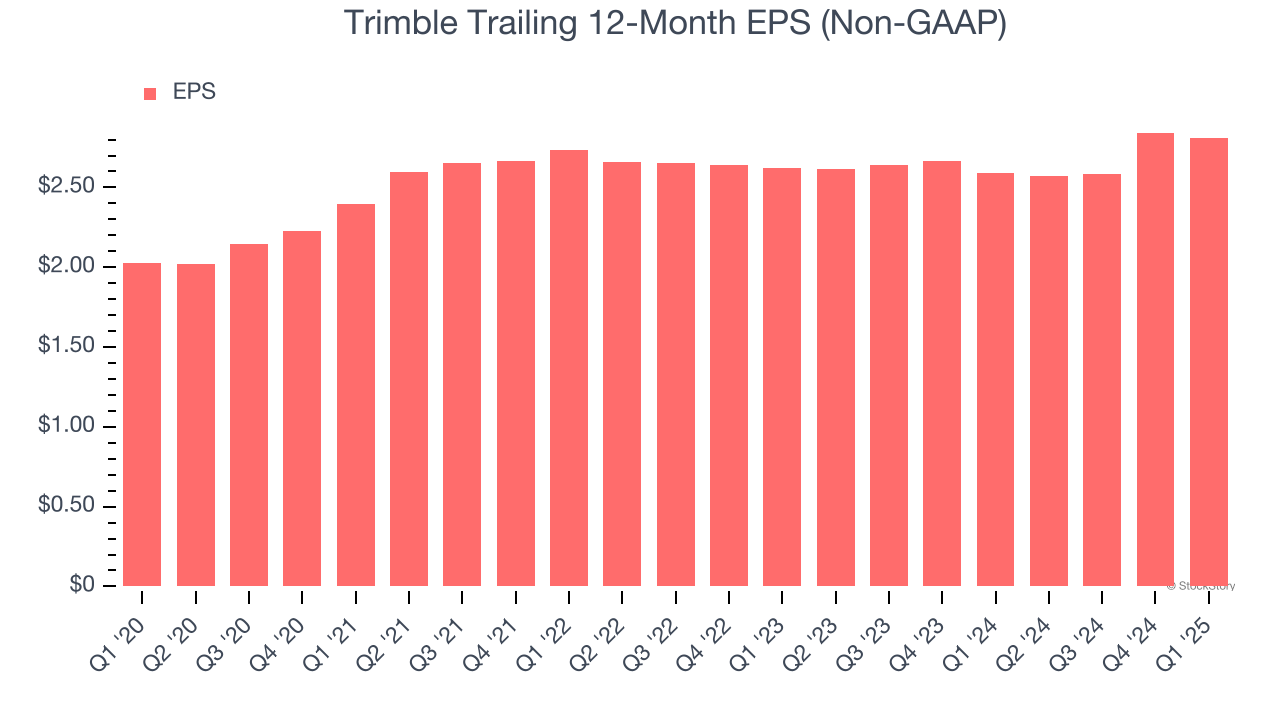
We can take a deeper look into Trimble’s earnings to better understand the drivers of its performance. A five-year view shows that Trimble has repurchased its stock, shrinking its share count by 2.2%. This tells us its EPS outperformed its revenue not because of increased operational efficiency but financial engineering, as buybacks boost per share earnings. 
Like with revenue, we analyze EPS over a more recent period because it can provide insight into an emerging theme or development for the business.
For Trimble, its two-year annual EPS growth of 3.5% was lower than its five-year trend. We hope its growth can accelerate in the future.
In Q1, Trimble reported EPS at $0.61, down from $0.64 in the same quarter last year. Despite falling year on year, this print beat analysts’ estimates by 4.4%. Over the next 12 months, Wall Street expects Trimble’s full-year EPS of $2.81 to grow 6.4%.
Key Takeaways from Trimble’s Q1 Results
We were impressed by how significantly Trimble blew past analysts’ revenue, EPS, and EBITDA expectations this quarter. On the other hand, its EPS guidance for next quarter missed significantly. Still, this print had some key positives. The stock traded up 2.7% to $65 immediately following the results.
Is Trimble an attractive investment opportunity at the current price? If you’re making that decision, you should consider the bigger picture of valuation, business qualities, as well as the latest earnings. We cover that in our actionable full research report which you can read here, it’s free.







